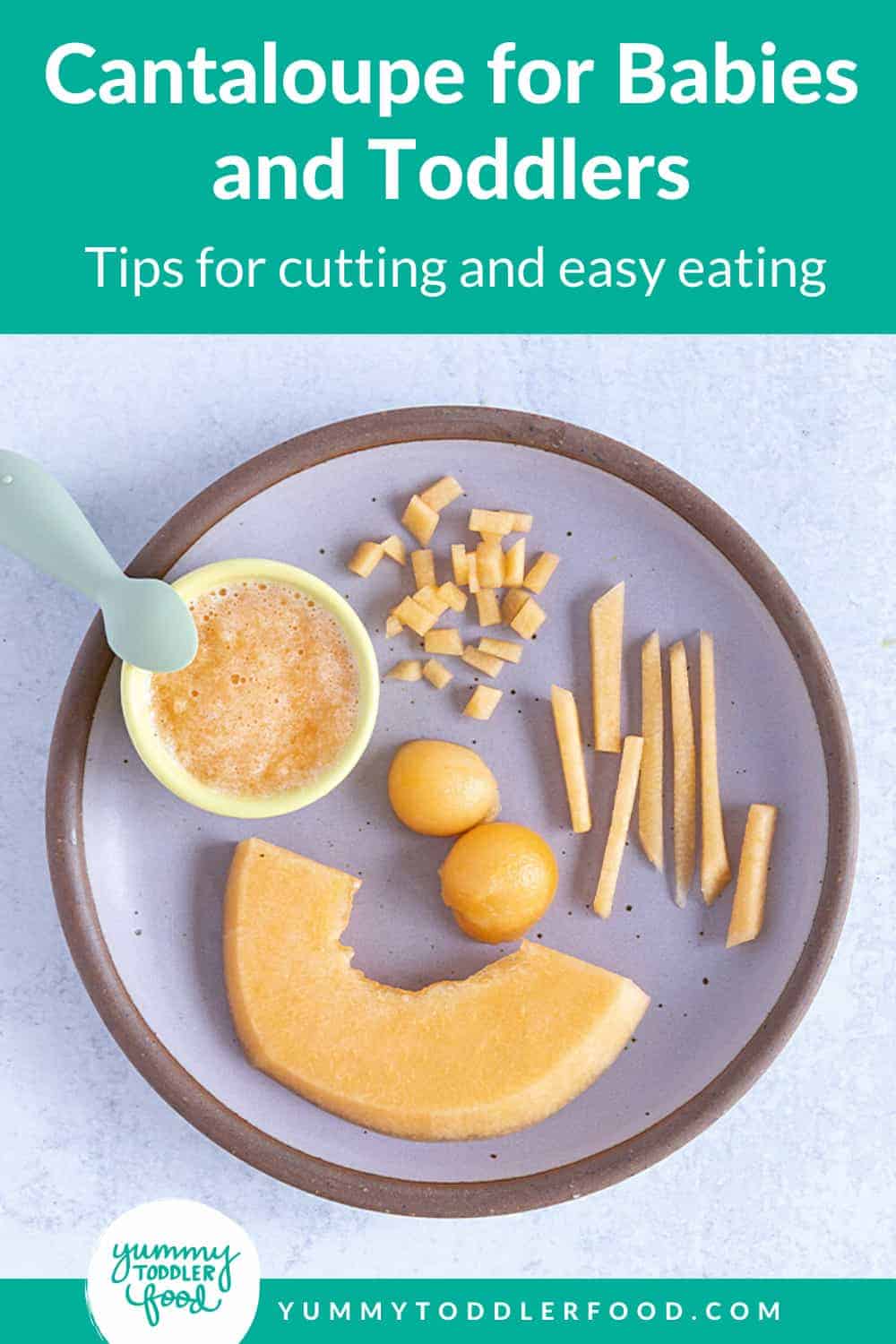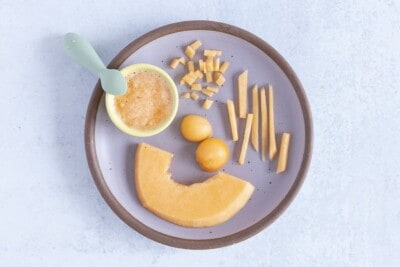[ad_1]
Learn safe ways to serve cantaloupe to a baby (and to toddlers) with this easy guide. With tips on how to cut cantaloupe easily, which shapes are easiest to eat, and how to choose a ripe cantaloupe.

Cantaloupe for Baby
A ripe cantaloupe is one of my family’s very favorite fruits. My kids even have a phrase for a really good one: “Cantaloupe heaven”. This fruit, which is a great source of hydration and Vitamin C, is a delicious side dish or snack to share with the kids from soon after they start solids.
Because many cantaloupes (and honeydew) can be a little firm, there are some basic guidelines to keep in mind when preparing them for a baby and toddler.
Below, I’ll share how to choose a cantaloupe, how to remove the skin and seeds, a few easy ways to cut them, and how to make a simple cantaloupe puree.
This info works for kids of all ages (and parents!) and is handy to save for peak melon season.

How to Choose a Cantaloupe
When choosing a cantaloupe, regardless of the variety, you want it to feel heavy for its size (which indicates a lot of juice), to have a slight give when you press on the base where the stem was removed, and to smell like a fragrant melon.
If a melon is rock hard and has no fragrance, it is less likely to have delicious flavor. If a melon is really soft and gives a lot when you touch it, it is likely overripe.
The skin of a cantaloupe should be fairly uniform, but sometimes there is slight discoloration on the spot it was sitting on the ground, which is fine.

How to Cut Cantaloupe Step-by-Step
This is how I prefer to cut a melon like a cantaloupe to share with the kids.
- Use a knife to cut the melon in half. This exposes the seeds. Use a spoon to remove the seeds and discard.
- Use a small knife to remove the skin. I hold the melon cut side down in one hand and use the other hand to gently remove the skin working around in a circle. You can also place the melon cut-side-down on the counter and remove the skin.
- Cut the half in half, then into slices.
- Or, you can use a melon baller to make round shapes for older kids. (You don’t have to peel it to use this method, though know it’s often hard to get all of the melon off the skin with a melon baller.
From there, you can slice the cantaloupe into matchsticks or into small diced pieces as you like.

Can a baby eat cantaloupe?
Yes, here’s how I prefer to offer this type of melon to kids according to their age:
- 6 months: Offer a large slice for baby baby-led weaning style. Make sure it’s ripe and not firm, to reduce the risk of choking. You can also blend fresh cantaloupe into a simple puree.
- 9 months: Offer small diced pieces as a finger food. (Again, make sure the melon is ripe and very soft.)
- 12+ months: Offer matchstick shape pieces of cantaloupe.
- 18+ months: Offer thicker slices for the toddler to take bites from.
How do I prepare cantaloupe for my baby?
You can offer a thick slice, cut it into small pieces, or puree it into a sort of juice, depending on the age of the child and your preference.
How do I give my 7-month-old melon?
For this age, you can offer a large slice for baby to gnaw on baby-led weaning. Make sure it’s ripe and not too firm, which reduces the risk of choking.
You can also blend fresh, ripe cantaloupe into a simple puree by adding pieces to a blender and blending smooth. Then you can offer it on a baby spoon or in a reusable pouch.

Can babies eat pureed cantaloupe?
Sure, pureeing ripe cantaloupe is an easy baby food option that can be served with a spoon or in a reusable pouch.
Best Tips for Success
- Be sure to start with a ripe, soft melon to reduce the risk of choking.
- Look for a melon that gives slightly at the base and smells fragrant.
- Offer cantaloupe to a 6-month-old baby as either a thick slice for baby-led weaning or as a puree.
- Offer cantaloupe to a 9-month-old baby, as long as the melon is very ripe and soft, diced into very small pieces.
- Offer it as matchstick-size pieces to a 12+ month baby, as long as the melon is very ripe and soft.
- Offer larger pieces, again as long as soft and ripe, to toddlers 18+ months.
- You can add fresh chunks of cantaloupe to a blender and blend smooth to make a fresh puree.
- You may also like Grapes for Kids, Apples for Babies, Bananas for Babies, easy Baby Food Combinations, and fresh Watermelon Juice.
I’d love to hear your feedback on this post, so please comment and rate it below!

Cantaloupe Puree
-
Cut the melon in half. Scoop out the seeds with a spoon and discard .Use a knife to remove the skin. Roughly chop at least 2 cups of the melon. (You can eat the rest yourself or store it in the fridge for future use.) Add melon to a blender and blend smooth. Serve with a spoon or in a reusable pouch.
Sliced and Diced Cantaloupe
- Be sure to start with a ripe, soft melon to reduce the risk of choking.
- Look for a melon that gives slightly at the base and smells fragrant.
- Offer cantaloupe to a 6-month-old baby as either a thick slice for baby-led weaning or as a puree.
- Offer cantaloupe to a 9-month-old baby diced into very small pieces, as long as the melon is very ripe and soft.
- Offer it to a 12+ month baby, as long as the melon is very ripe and soft, as matchstick pieces.
- Offer larger pieces, again as long as soft and ripe, to toddlers 18+ months.
- You can add fresh chunks of cantaloupe to a blender and blend smooth to make a fresh puree.
- Store leftover melon or puree in an airtight container in the fridge for up to 5 days.
Serving: 0.25cup, Calories: 23kcal, Carbohydrates: 6g, Protein: 1g, Fat: 1g, Saturated Fat: 1g, Polyunsaturated Fat: 1g, Monounsaturated Fat: 1g, Sodium: 21mg, Potassium: 108mg, Fiber: 1g, Sugar: 5g, Vitamin A: 2334IU, Vitamin C: 8mg, Calcium: 6mg, Iron: 1mg
[ad_2]
Source link

